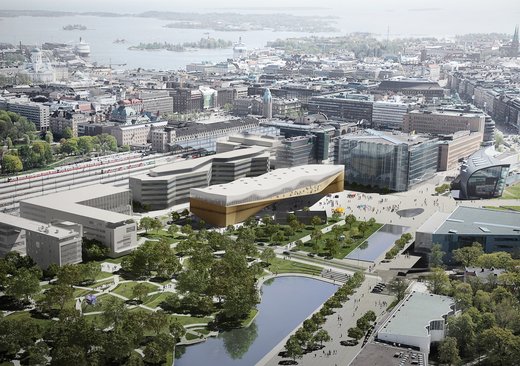18 November 2013
By Aarni Heiskanen in Helsinki
When you fly over Finland, most of what you see from the air is forest and you would guess that the Finns are masters in building things from wood. Well, guess again. When it comes to high-rise wooden construction, Finland lags behind Norway and even France!
A recent architectural competition to design a central library for the city of Helsinki fired up the debate on timber construction. The winning design by ALA Architects has a large curvilinear facade made of wood.
It’s slated to open in 2017, but some worry its daring design will be altered.

The winning design, by ALA Architects, for Helsinki’s new central library has a large curvilinear facade made of wood (ALA Architects)
“I’m sure that the building industry will try to turn it into a concrete building,” Professor Pekka Heikkinen of Aalto University told a leading Finnish newspaper.
The leader of the government’s wood construction program, architect Markku Karjalainen, made a similar comment: “Someone will certainly come and say, don’t be fools, shouldn’t we build it in concrete?”
Between 1995 and 2012, only three office buildings and 37 high-rise apartment buildings were constructed using wood in Finland.
One of the reasons why high-rise timber construction has not been popular is concern over safety. Old Finnish towns were once built almost entirely of wood and would burn down easily.

Â
The origin of Helsinki’s capital status dates back to 1827 when the original first city, Turku, turned to ashes due to a careless maid’s torch. Wooden buildings with more than two floors were banned until the 1990s. Now the maximum floor count is eight, but with additional precautions you can build even higher.
Even if the fire safety issue can be managed fairly easily these days, many developers and contractors see another risk with multi-storey wood buildings. Since they are fairly rare, municipal authorities have different views on how to apply the rules and regulations. That can potentially add costs or slow down projects.

Â
Builders are reluctant to take the risks that stem from the new way of building. Problems with sound insulation between floors and the maintenance of wooden facades are at the top of the list. A timber construction with more than two floors is more expensive than a building of concrete, owing partly to technical issues, partly to lack of competition.
Many problems with constructing in wood are due to underdeveloped business thinking. Forestry revolves around raw materials, pulp and paper. Housebuilders have always used wood, but the modular technology for office buildings or apartment blocks is still in its infancy.

Â
It seems that traditional contractors are easing up gradually. In 2016, Stora Enso and SRV, the contractor, will erect Wood City in Helsinki. It will be an eight-story city block with residential, office and hospitality units, made entirely of wood.
The story of wood in Finnish construction can take a positive turn. However, one thing is almost shameful. We have the fifth largest supply of wood in Europe and we’re very committed to sustainability. However, local companies have to import environmentally certified wood from Germany, since Finnish forest owners have neglected to get certified.
Aarni Heiskanen is the managing partner of AE Partners. Visit http://aepartners.fi/










